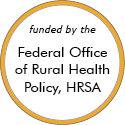Substance Use and Misuse in Rural Areas – Models and Innovations
These stories feature model programs and successful rural projects that can serve as a source of ideas and provide lessons others have learned. Some of the projects or programs may no longer be active. Read about the criteria and evidence-base for programs included.
Other Project Examples
School-Based Drug Misuse Prevention Program
Updated/reviewed July 2023
- Need: School-based drug misuse prevention program in Appalachian Ohio, a need triggered by a high school student's overdose death.
- Intervention: Implementation of the HOPE curriculum, an age-appropriate K through 12th grade drug abuse prevention program.
- Results: No further drug overdose deaths after curriculum initiated.
MIST: Mothers and Infants Sober Together

Updated/reviewed May 2023
- Need: To address the needs of pregnant women who are using substances and infants born into drug-positive families.
- Intervention: The Mothers and Infants Sober Together (MIST) program assisted mothers who used substances get treatment and provide a safe, drug-free home for themselves and their newborn.
- Results: MIST has helped mothers find treatment and education and has helped children grow up in safe and healthy homes.
Addiction Recovery Mobile Outreach Team (ARMOT)

Updated/reviewed January 2023
- Need: To reduce the number of overdoses and overdose-related deaths from opioids in rural Pennsylvania.
- Intervention: ARMOT provides 1) case management and recovery support services to individuals with substance use disorders and 2) education and support to rural hospital staff, patients, and their loved ones.
- Results: Since 2015, ARMOT has received over 2,956 referrals.
ASPIN's Certified Recovery Specialist Program


Updated/reviewed September 2022
- Need: Improved approach in addressing the behavioral health and primary care disparities of Indiana's rural counties.
- Intervention: A network was established that trained community health workers (CHWs) to be certified health insurance enrollment navigators and provide mental health services.
- Results: This year, ASPIN trained 230 CHWs, cross-trained 70 behavioral health case managers as CHWs, and 35 individuals in the Indiana Navigator Pre-certification Education.
Isanti County SafeCab Program
Updated/reviewed August 2022
- Need: To reduce the number of deaths and injuries caused by drunk driving in Isanti County.
- Intervention: The SafeCab program provides alternative transportation home for bar patrons who would otherwise drive impaired.
- Results: The program is credited with a significant decrease in DUI (Driving Under the Influence) arrests and the lower average corresponding BAC (Blood Alcohol Content) levels in Isanti County.
Staggered Sentencing for Repeat Drunk Driving Offenders
Updated/reviewed August 2022
- Need: To reduce the incidences of repeat drunk driving.
- Intervention: Repeat DWI (driving while intoxicated) offenders were given a staggered sentence, allowing them to serve their sentence in segments of time, typically separated by several months to a year. The offender was able to file a motion to request a waiver for the remaining sentence period(s), if able to show that he/she maintained sobriety.
- Results: The incidence of recidivism, or crime relapse, has been reduced among offenders given staggered sentences, by comparison to offenders given traditional DWI sentences. The program has also reduced the average cost of jail time that otherwise would have been served from a full sentence.
Seneca Strong's Certified Addiction Recovery Coaches
Updated/reviewed July 2022
- Need: The Seneca Nation of Indians has experienced disproportionate rates of opioid, alcohol, and substance misuse.
- Intervention: The Seneca Nation Government and Executives founded Seneca Strong, a recovery peer advocate program, with the goal of reducing substance misuse across the Nation.
- Results: Seneca Strong has since grown in personnel and capacity to meet the needs of the Allegany and Cattaraugus territories of the Seneca Nation.
Pathways Vermont Housing First Program
Updated/reviewed April 2021
- Need: Ending a local Vermont population's homelessness experience.
- Intervention: In 2010, Pathways Vermont implemented a first-of-its-kind, rural-focused Housing First program in order to provide housing and support services to those with mental health and substance use conditions experiencing homelessness.
- Results: Since its initial start-up, Pathways Vermont has assisted over 560 Vermonters — about 70% from rural areas — experiencing homelessness using the Housing First model. The organization has collaborated with the state mental health department, corrections department, local healthcare systems and providers, and other organizations to end homelessness. In addition, programmatic work has expanded to reach other local populations, including veterans and at-risk families.
Last Reviewed: 6/28/2023

